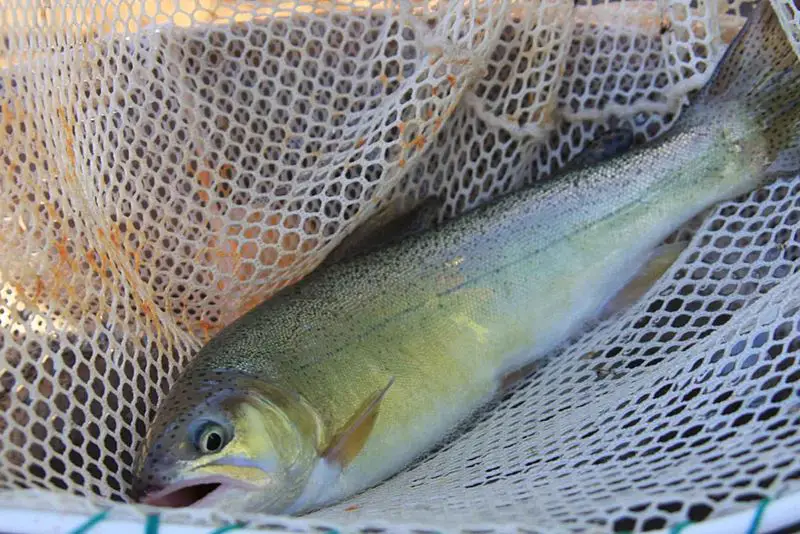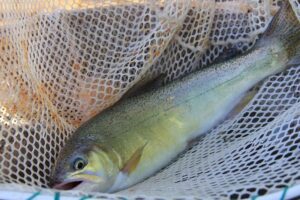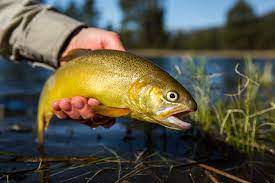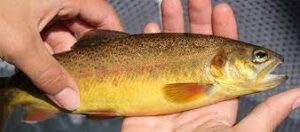This post was last updated on August 18th, 2021 at 10:19 pm
(Oncorhynchus gilaeis) another gorgeous fish found in the south west United States. Although, for many years, no angler in this area was able to fish for the Gila trout, lots of conservation, protection, and preservation efforts have worked over the years to change this in a few limited areas. If you are interested in this great fish species, read on. We will talk about where this fish normally live, threats in the wild, size of mature fish, and much more.
Copper-Colored Beauty: The Gila Trout

Gila Trout Identification
This species is normally found to be a golden to copper color along the sides of the body, with a head that appears yellower than the rest of the body. Along the back, this golden body appears to fade into a greenish or olive color. Black spots line the upper body. Just like the Apache trout, which the Gila is related to, both these fish might have the black spots near their eyes that make it appear that they have mask marks near their eyes. However, unlike the Apache trout, no Gila trout has big spots on the body. Adults that are spawning may sport a pinkish band along their bellies, which are normally white with red, yellow, or orange spots.
Where to find Gila Trout
Historically, there have been population of this trout species in several streams in both Arizona and New Mexico. The largest populations in the wild were found at the headwaters of Gila Creek in New Mexico. They prefer cool streams (under 77 degrees) with quite a bit of silt in higher elevations (over 5,400 feet). Much like some of the trout found in the same states, these fish also need clean gravel for spawning purposes. They can frequent pretty small headwater streams that seem pretty shallow, but have a few very deep pools that can be used for protection during times of drought or dryer seasons.
Gila Trout Spawning
As mentioned above, you may tell that Gila trout are mature (about 3 years old) and spawning by the salmon colored streak along their normally white belly. In the wild, spawning can happen from early spring to early summer. They prefer the rising temperature to lay their eggs. Normally, these eggs are laid in either sand or gravel. Each female only produces around 75-150 eggs. Unfortunately, just like some other native trout that are trying to be protected, Gila’s can hybridize with rainbow trout in streams where both are found.
Gila Trout Size and Growth
By the end of their first summer of life, a gila can be from 2 to 4 inches long. On average, this fish will be about 11.8 inches long when mature. The largest one ever caught measured 21.7 inches long. These trout will eat nearly anything, and, usually, their overall size is dependent upon how much food is available in the area, as well as several other overall factors, including habitat, the temperature of the stream, other species in the area, and how long the growing season lasts in the area.
Competition and Threats
Sadly, this gorgeous, large trout has been threatened for years, not only by the introduction of other species for sport fishing, but also from other threats. Over harvest, wildfires in conservation areas, contamination of their habitats, human interaction through roadwork, hybridization with other species and genetic loss, as well as predation from other species, both native and introduced, have all greatly contributed to the threats to this species. Currently, restocking efforts and more have been trying to keep populations level in areas, or add to the population in various streams. These conservation and protection efforts have had mixed results, and wildfires continue to be a threat, even in streams that are protected.
Are Gila Trout Endangered?
This species is still considered endangered, and was one of the first fish species (along with the Apache trout) to be protected under the original Endangered Species Act. They are still considered “threatened,” but a special law was passed to allow for some sport fishing. The areas where sport fishing is allowed are normally stocked with Gila trout just for this purpose, and fishing is limited, even in these areas. In other areas, a catch and release police is in place for these trout.
A “Newly,” Introduced Fish to Anglers
Even though these fish were once fished to the point of extinction, for the first time in over 100 years, anglers can again enjoy fishing for them. Lakes and streams in some areas in New Mexico may allow fishing for this species. Be sure to ask wildlife management officials for your particular area about what their current rules are about fishing or catching them in your specific area. These fish can normally be caught by many of the same fishing techniques that you would use to catch rainbow’s. This includes spinners, smaller spoons and of course fly fishing is always an option for the gila trout.
Gila Trout Pictures
Gila Trout FAQ
How do you identify a Gila trout?
Gila Trout have a short, stocky body that is moderately compressed with a yellowish golden body coloration.
Where do you fish for Gila Trout?
Gila trout are most prevalent in several streams in both Arizona and New Mexico.





